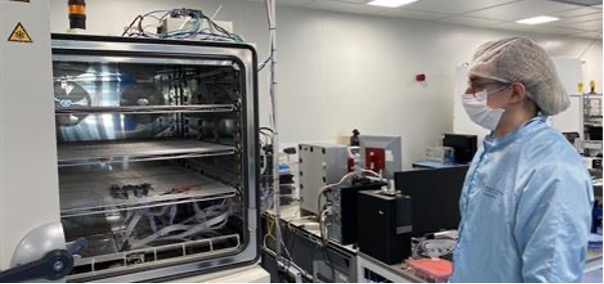Major upgrades to the Large Hadron Collider (LHC) at CERN are currently being planned for its shutdown in 2026-2028. These improvements will increase its beam intensity, allowing it to increase its collision rate by a factor of three. The project is known as the High Luminosity LHC (HL-LHC).
ATLAS is one of four particle physics experiments at the LHC. Its inner detector, the first part of the experiment to see the decay products of the collisions, is to be entirely replaced. This is due in part to the deterioration of the materials caused by the high radiation environment of the LHC. The replacement will also allow the detector to be brought up to date with technical advancements.
ATLAS ITk model for the future HL-LHC upgrade. PPD is working on the design and testing of the strip barrel and the pixel end-cap. Photo: CERN, annotations added.
The new ATLAS all-silicon Inner Tracker (ITk) is designed to cope with the increased data rates and radiation levels of the LHC. It will also improve ATLAS' ability to measure the tracks of particles produced in the collision, to a precision of less than the width of a human hair.
This work is being carried out by a large group of international universities and institutions, including 15 from the UK. At RAL, the STFC Particle Physics and Technology Departments are contributing to the design, construction and testing of two major parts of the ITk. Specifically, teams are placing silicon strip modules on double-sided local support systems called staves in the strip barrel, and pixel modules on the pixel endcaps.
Pixel modules have better precision than silicon strip modules so are put close to where the collision takes place. However, they are also more expensive, so silicon strip modules are put further away from the interaction point. This allows additional tracking data to be taken at a reduced cost.
Strip Modules
The ITk strip modules will be positioned in the outer section of the inner detector. These modules are built from a silicon sensor and flexible printed circuit boards called hybrids, which are glued onto staves.
Two different support structures, made of carbon fibre, provide mechanical stability, cooling, power, and data transmission.
ATLAS Mock-Up Model
A wooden mock-up model of the strip barrel has been built to allow researchers and technicians to practice the installation of the completed strip barrel staves within the inner tracker. This allows any design changes to be made before the upgraded detector is installed.
Peter Anthony, an instrument specialist from the Technology Department who is working on the model, said:
“Making models of things before creating and installing them is not only cost-effective in the long run but also proves concepts of what you are doing, allowing any potential issues to be noticed and fixed before real-life applications. Trying something at a smaller scale may discover problems that may occur at a larger scale, so it is better to work out if something is achievable before building it in full".
Left: ATLAS mock-up model used for stave insertion tests. Right: Close-up of two prototype silicon strip staves. Photo: Peter Phillips.
Pixel Endcaps
Pixel endcaps will be placed on each end of the barrel. They consist of a half ring with a carbon foam core and glued pixel modules per side, which are similar to CCDs found in cameras.
Left: A pixel end-cap half-ring, supported by an aluminium structure. Right: close-up of a pixel end-cap module.
Next-generation microscope showing the wire bonding that allows data to be read out from the pixel module.
As the particle detector runs, its electrical components heat up. These components can be damaged when operated at high enough temperatures, particularly after being damaged by radiation, so the strip modules and pixel endcaps have integrated titanium cooling tubes containing liquid CO₂. This cools the system to temperatures as low as -35 ° C.
In the cleanroom, electrical tests are carried out on the modules to ensure they are performing as predicted.
Looking to the future
STFC and CERN' s goal is to deepen the understanding of how the universe works on the smallest scales.
Dr Ben Smart, an experimental physicist working at RAL on the ITk upgrade, said:
“This upgrade will allow the ATLAS experiment to push the frontiers of particle physics, with improved measurements and new discoveries, to deepen our knowledge of the fundamental mechanisms of the universe in which we live.
The cutting-edge technology we are developing for the ITk will benefit ATLAS, future experiments, and global society as a whole."
If you're interested in learning more about the project or visiting the ATLAS mock-up model, please contact Ben Smart or Peter Anthony.

PPD Interim Director Dr Jens Dopke alongside the climate chamber, located in the clean room.
